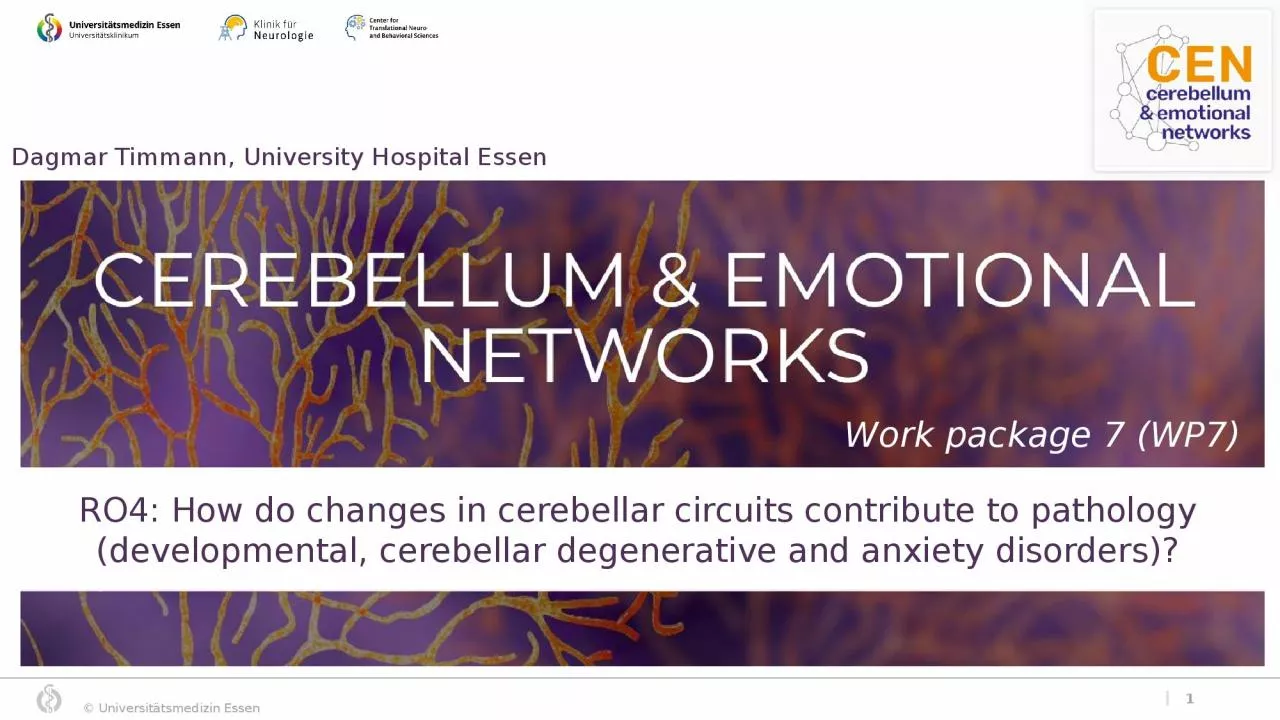

Dagmar Timmann University Hospital Essen Work package 7 WP7 2 RO4 How do changes in cerebellar circuits contribute to pathology developmental cerebellar degenerative and anxiety disorders ID: 1038285
Download Presentation The PPT/PDF document "1 RO4: How do changes in cerebellar cir..." is the property of its rightful owner. Permission is granted to download and print the materials on this web site for personal, non-commercial use only, and to display it on your personal computer provided you do not modify the materials and that you retain all copyright notices contained in the materials. By downloading content from our website, you accept the terms of this agreement.
1. 1RO4: How do changes in cerebellar circuits contribute to pathology (developmental, cerebellar degenerative and anxiety disorders)?Dagmar Timmann, University Hospital Essen Work package 7 (WP7)
2. 2RO4: How do changes in cerebellar circuits contribute to pathology (developmental, cerebellar degenerative and anxiety disorders)?The mission of CENTo be a virtual institute for the interdisciplinary study of cerebellar contributions to survival circuits and emotional behaviour with the ambition of translating the findings into clinical developments. Anxiety disordersSocial anxiety disorder (Social phobia)Fear and anxiety in social situationsTomas FurmarkProf. Psychology / Emotion Psychol.Uppsala Universitet, SwedenKristoffer MånssonProf. Medical Science / Clin. Neurosci.Karolinska Institutet, Sweden
3. 3RO4: How do changes in cerebellar circuits contribute to pathology (developmental, cerebellar degenerative and anxiety disorders)?The mission of CENTo be a virtual institute for the interdisciplinary study of cerebellar contributions to survival circuits and emotional behaviour with the ambition of translating the findings into clinical developments. Anxiety disordersSocial anxiety disorder (Social phobia)Fear and anxiety in social situationsCerebellar disordersSpinocerebellar ataxia type 6 (SCA6) CCAS: Cerebellar Cognitive Affective SyndromeDagmar TimmannProf. Experimental Neurology / Head of Ataxia ClinicEssen University Hospital GermanyTomas FurmarkProf. Psychology / Emotion Psychol.Uppsala Universitet, SwedenKristoffer MånssonProf. Medical Science / Clin. Neurosci.Karolinska Institutet, Sweden
4. Tomas FurmarkProf. Psychology / Emotion Psychol.Uppsala Universitet, SwedenKristoffer MånssonProf. Medical Science / Clin. Neurosci.Karolinska Institutet, Sweden4RO4: How do changes in cerebellar circuits contribute to pathology (developmental, cerebellar degenerative and anxiety disorders)?The mission of CENTo be a virtual institute for the interdisciplinary study of cerebellar contributions to survival circuits and emotional behaviour with the ambition of translating the findings into clinical developments. Anxiety disordersSocial anxiety disorder (Social phobia)Fear and anxiety in social situationsCerebellar disordersSpinocerebellar ataxia type 6 (SCA6) CCAS: Cerebellar Cognitive Affective SyndromeDagmar TimmannProf. Experimental Neurology / Head of Ataxia ClinicEssen University Hospital GermanyDevelopmental disordersAutism Spectrum Disorder Social functioning deficits Social anxietyProf. Peter KindDr. Sally TillDr. Thomas WatsonSimons Initiative for the Developing Brain, University of Edinburgh, UKRodentsHumansHumansfunctional Magnetic Resonance Imaging (fMRI)
5. 5RO4: How do changes in cerebellar circuits contribute to pathology (developmental, cerebellar degenerative and anxiety disorders)?The mission of CENTo be a virtual institute for the interdisciplinary study of cerebellar contributions to survival circuits and emotional behaviour with the ambition of translating the findings into clinical developments. Anxiety disordersSocial anxiety disorder (Social phobia)Fear and anxiety in social situationsTomas FurmarkProf. Psychology /Emotion Psychol.Uppsala Universitet, SwedenKristoffer MånssonProf. Medical Science Karolinska Institute, SwedenCerebellar disordersSpinocerebellar ataxia type 6 (SCA6) CCAS: Cerebellar Cognitive Affective SyndromeDagmar TimmannProf. Experimental Neurology/ Head of Ataxia ClinicEssen University Hospital GermanyDevelopmental disordersAutism Spectrum Disorder Social functioning deficits Social anxietyProf. Peter KindDr. Sally TillDr. Thomas WatsonSimons Initiative for the Developing Brain, University of Edinburgh, UKRodentsHumansHumansNeural circuits for fear and anxiety - the missing linkApps R, Strata P. Nat Rev Neurosci. 2015VTAfunctional Magnetic Resonance Imaging (fMRI)
6. 6RO4: How do changes in cerebellar circuits contribute to pathology (developmental, cerebellar degenerative and anxiety disorders)?Anxiety disordersDevelopmental disordersESR14: The function of the cerebellum in disorders of the affective spectrumESR15: Role of the cerebellum in approach-avoidance motivational statesContribution of the human cerebellum to fear learningESR10: 7T fMRI studies in healthy participants including pharmacological interventionsESR11: Characterisation of the cerebellum and emotional networks in a transgenic rate model of autism spectrum disorder (ASD)ESR13: 7T fMRI studies in patients with cerebellar degenerationESR12: Using 7T fMRI to characterise cerebellar interactions with large-scale fear networks related to fear behaviour in a transgeneic rat model of ASDPhD projectsFear conditioning paradigmsCerebellar disorders
7. 7RO4: How do changes in cerebellar circuits contribute to pathology (developmental, cerebellar degenerative and anxiety disorders)?Anxiety disordersCerebellar disordersDevelopmental disordersEarly stage researchersESR10: Alice DoubliezESR13: Enzo NioESR11: Mahdie GhaneESR12: Jing YeESR14: Patricia Paterna UppsalaESR15: Tugce Yildiz Karolinska
8. 8RO4: How do changes in cerebellar circuits contribute to pathology (developmental, cerebellar degenerative and anxiety disorders)?Anxiety disordersCerebellar disordersDevelopmental disordersSecondments / Training visitsESR10: Alice DoubliezESR13: Enzo NioESR11: Mahdie GhaneESR12: Jing YeESR14: ESR15: Pavia: training in computational Patrick Wild Centre: trai-ning in pre-clinical/clinical outreach.Edinburgh: training in animal 7T MRIAtaxiaUK: training in NGO workKarolinska/Uppsala: fMRI analysis Edinburgh: animal 7T MRIPatrick Wild Centre: outreach.Rehab Kettwig: patient acquisitionKarolinska/Uppsala: fMRI analysisAtaxiaUK: training in NGO workParis: training in viral/optogenetic toolsKarolinska/Uppsala: fMRIEssen: fMRI in humansAtaxiaUK: training in NGO workPatricia Paterna Tugce Yildiz